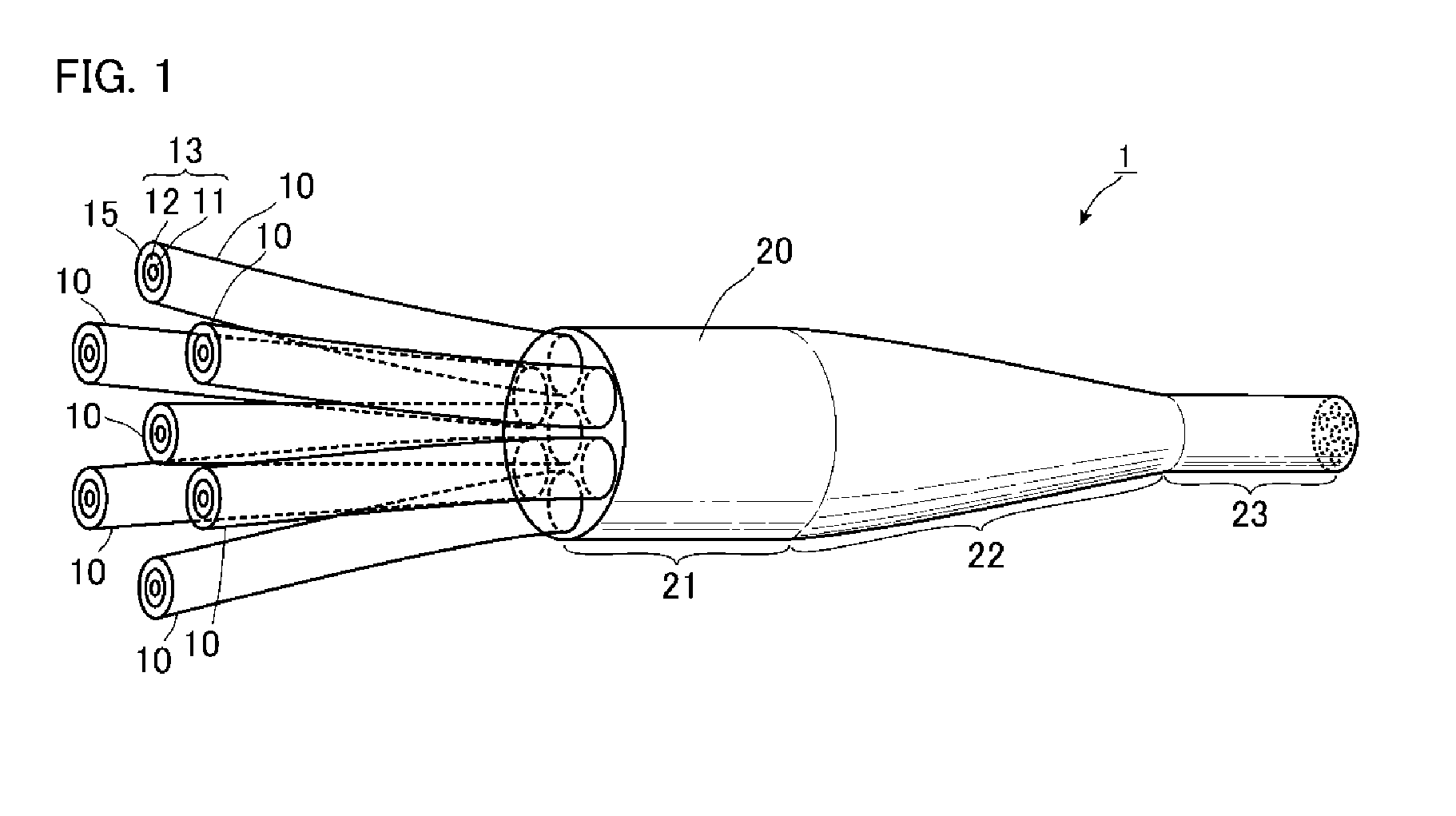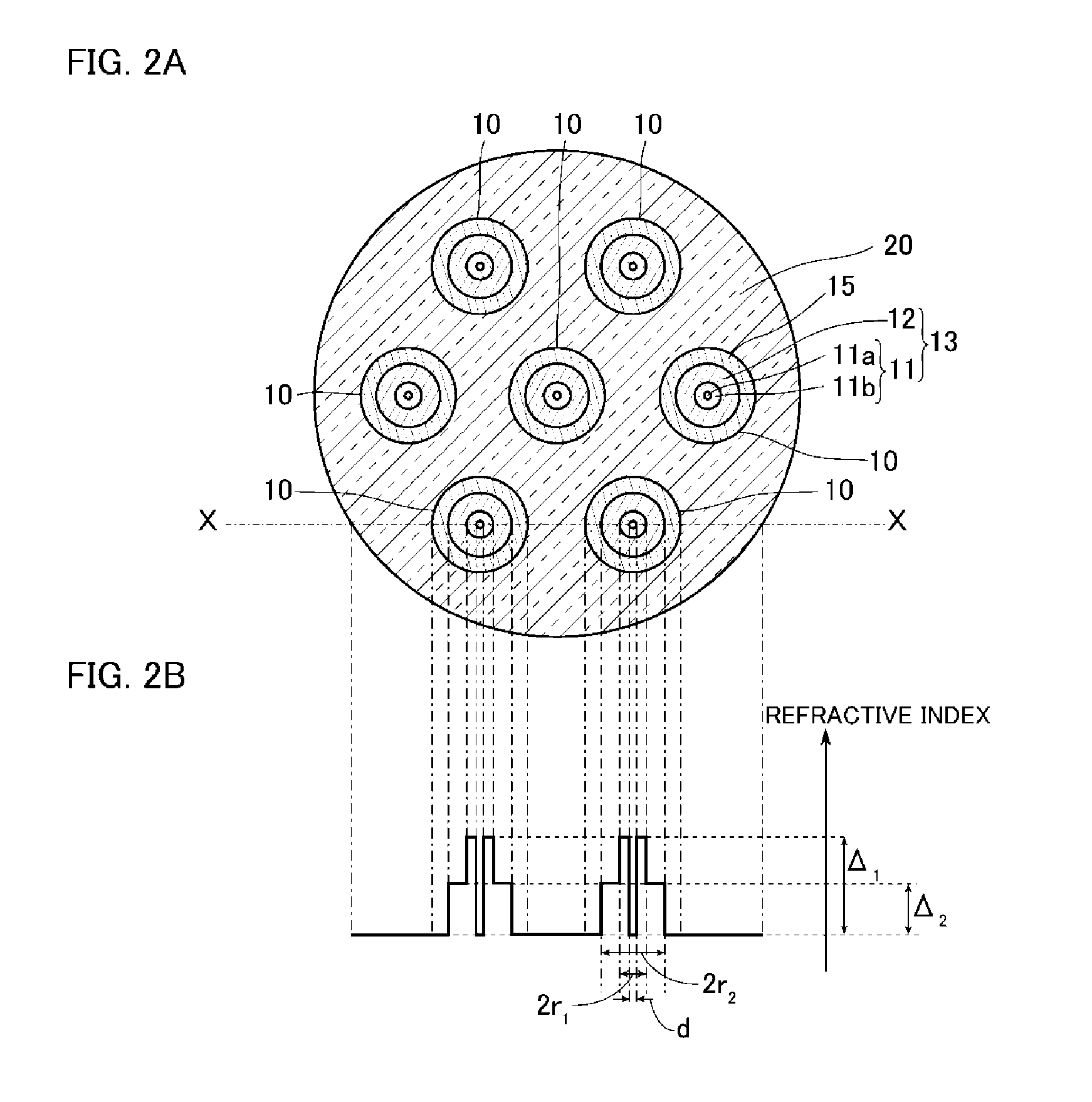Optical device
a technology of optical devices and optical components, applied in the field of optical devices, can solve the problems of large light loss and the sudden change of the mode field diameter of light of at least one of the modes, and achieve the effect of suppressing light loss
- Summary
- Abstract
- Description
- Claims
- Application Information
AI Technical Summary
Benefits of technology
Problems solved by technology
Method used
Image
Examples
first embodiment
[0039]FIG. 1 is a view illustrating an optical device according to a first embodiment of the present invention. As illustrated in FIG. 1, an optical device 1 of the present embodiment includes multiple relay fibers 10 and a capillary 20 as main components. In this example, the number of relay fibers 10 is seven.
[0040]The relay fibers 10 are inserted into the capillary 20 from one end to the other end thereof, and the relay fibers 10 and the capillary 20 are integrated without any gap therebetween. Parts of the relay fibers 10 that are not inserted into the capillary 20 are exposed.
[0041]The capillary 20 is circular in cross-section, and includes a large diameter portion 21, a tapered portion 22, and a small diameter portion 23 formed along the longitudinal direction. Such a shape is formed as follows. First, a capillary having through-holes formed therein and having a constant thickness is provided, the number of through-holes being the number of relay fibers 10 to be inserted, and ...
second embodiment
[0053]Next, a second embodiment of the present invention will be described. Here, components that are identical or similar to those in the first embodiment are designated by the same reference numerals and redundant description will not be repeated unless the description is particularly stated.
[0054]FIG. 4 is a view illustrating an optical device according to the second embodiment of the present invention, and FIGS. 5A and 5B are diagrams illustrating a state of a cross section perpendicular to the longitudinal direction of the optical device 2 of FIG. 4. As illustrated in FIGS. 4, 5A, and 5B, the optical device 2 of the present embodiment is different from the optical device of the first embodiment in that the outer circumferential surface of the core 13 is surrounded by cladding 25 made of the same glass material as the capillary 20 of the first embodiment without any space therebetween and that the core 13 is positioned only in the cladding 25. Specifically, the optical device 2 ...
example 1
[0063]A simulation is conducted using the optical device 1 of the first embodiment as a model. In the present model, the low-refractive-index portion 11a had a refractive index equal to that of the cladding 15 similarly to the first embodiment. Furthermore, the ratio (d / 2r1) of the diameter d of the low-refractive-index portion 11a of the inner core 11 to the outer diameter 2r1 of the high-refractive-index portion 11b is set to 0.3.
[0064]Subsequently, conditions under which the effective area Aeff of light in the LP01 mode is 110 μm2 and the effective area Aeff of light in the LP11 mode is 170 μm2 at the large diameter portion 21 are obtained. Specifically, the radius r1 of the inner core 11 and the relative refractive index difference Δ1 of the high-refractive-index portion 11b from the cladding 15 are obtained for each of the cases where the relative refractive index difference Δ2 of the outer core 12 from the cladding 15 is 0.5, 1.0, and 1.5. The result is shown in Table 1.
[0065]...
PUM
 Login to View More
Login to View More Abstract
Description
Claims
Application Information
 Login to View More
Login to View More - R&D
- Intellectual Property
- Life Sciences
- Materials
- Tech Scout
- Unparalleled Data Quality
- Higher Quality Content
- 60% Fewer Hallucinations
Browse by: Latest US Patents, China's latest patents, Technical Efficacy Thesaurus, Application Domain, Technology Topic, Popular Technical Reports.
© 2025 PatSnap. All rights reserved.Legal|Privacy policy|Modern Slavery Act Transparency Statement|Sitemap|About US| Contact US: help@patsnap.com



